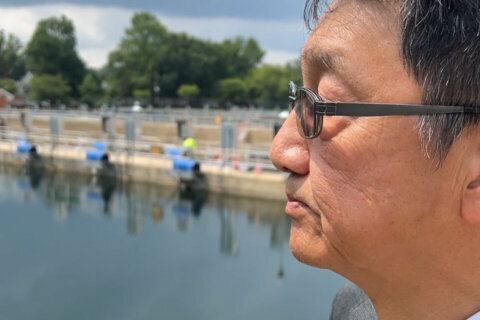This article was republished with permission from WTOP’s news partner InsideNoVa.com. Sign up for InsideNoVa.com’s free email subscription today.
This article was written by WTOP’s news partner InsideNoVa.com and republished with permission. Sign up for InsideNoVa.com’s free email subscription today.
Metro is up and running in Loudoun County.
Eight years after the first phase of the Silver Line opened five new stations in Fairfax County and more than 20 years since the full breadth of the Silver Line project was first planned, five new Silver Line stations opened in Fairfax and Loudoun counties Tuesday, extending the rail network’s reach to Dulles International Airport and Ashburn.
The extended Silver Line will not only carry passengers from Washington to Dulles, it will connect the five new stations to the high-frequency rail system, transforming development in and around the new stations at Reston Town Center, Herndon, Innovation Center, Dulles, Loudoun Gateway and Ashburn, the new western terminus of the line.
Regional and national officials packed the new Dulles Airport station Tuesday morning, saying the delays and cost overruns would be well worth it now that more job centers, travelers, commuters and others will be connected to the rest of the D.C. region by Metro.
“This Metro will allow the father who’s working two jobs to get home in time to see his kid’s soccer game. … This Metro will allow the single mom to get home in time to have dinner with her kids, to tuck them into bed,” Loudoun County Board Chair Phyllis Randall said.
A single-seat ride from the Metro Center station in downtown D.C. to the airport is expected to take 53 minutes and riding the entirety of the Silver Line – now the longest in the system – from Ashburn to Largo Town Center, should take about 93 minutes.
Coming in at a final construction cost of over $3 billion, the 11.4-mile second phase of the rail project opened more than four years after its original target date and more than $250 million over budget, paid for by Fairfax and Loudoun counties, as well as Dulles Toll Road revenues.
In just the last few years, the project underwent several stops and starts over issues like faulty concrete, wrong dimensions at a new Dulles rail yard, disputes between Metropolitan Washington Airports Authority and its contractors, and delays in Metro’s approval of the work due to failed inspections.
Sen. Mark Warner, D-Va., said he and others from Virginia’s Congressional delegation had to force some “frank and candid conversations” between MWAA, the Washington Metropolitan Area Transit Authority and the Washington Metrorail Safety Commission to finally get the project handed over from the airports authority to Metro and open.
“Good things take time. But it shouldn’t have taken this long,” Warner said.
But regional leaders on Tuesday were hopeful that the long-awaited opening could mark something of a turning point for the transit system. Former WMATA General Manager Paul Wiedefeld stepped down in May after defects that led to a 2021 derailment forced Metro to sideline all of its newest 7000-series railcars (about 60% of the system’s fleet) and an oversight failure led to safety certification lapsing for many Metro bus and rail operators.
Since taking over in June, new GM Randy Clarke has received high marks from some while overseeing the return of many 7000-series cars, integral to Tuesday’s opening by minimizing headways, or the time between trains. The agency is carrying out what it says was long-needed repair work on the Potomac River bridge that carries Yellow and Blue Line trains to and from Arlington and Alexandria, but it’s hopeful that a new Potomac Yards station will open on those lines early next year, once the work is completed.
“It’s really important that a culture of safety is maintained. I think it’s extraordinarily important as well that the 7000 car series are going to get back on the tracks,” Warner told reporters Tuesday. “I think Metro is on the way back. That’s good news for those folks that ride Metro, it’s good news as well for those folks who don’t ride Metro because it means … less cars on the road. So this is a giant step forward, but it’s going to require constant vigilance and oversight.”
Trains, for now, will run along the Silver Line every 15 minutes. And just like when stations first opened on Phase 1 back in 2014, the planned rail stops have already begun to reshape the areas around them with new residential, retail and office space that leaders say will bring more walkable and liveable communities to Fairfax and Loudoun.
Loudoun Supervisor and WMATA board member Matt Letourneau said that assessed property values around Phase 1 stops have grown by 168% since 2013, well outpacing other areas in Fairfax.
Also like Phase 1 – which opened the McLean, Tysons, Greensboro, Spring Hill and Wiehle-Reston East stations in 2014 – construction of the rail extension and stations was handled by MWAA. Metro has now taken control of the extension and will be responsible for all operations.
Clarke, MWAA CEO Jack Potter, most of Northern Virginia’s Congressional delegation, D.C. Mayor Muriel Bowser and U.S. Transportation Secretary Pete Buttigieg all spoke at the ribbon-cutting ceremony Tuesday morning. But one notable absence was Gov. Glenn Youngkin, who was not in attendance at the opening despite having little else on his public schedule.
“When the airport was first opened, almost exactly 60 years ago today, President Kennedy said that the building symbolizes the aspirations of the United States,” Buttigieg said. “I think the same can be said for the Silver Line today, allowing for people to affordably get to where they need to go, whether it is a baggage handler working at the airport or a federal employee, yes, commuting into the District of Columbia, or a software engineer working at the terrific tech employers that are here, so many will count on this and will benefit from it.”
Kaine, who like Warner was crucial to the project, remembered coming into the governor’s mansion in 2006 and telling his staff that he wanted to make sure the full Silver Line extension was finalized, approved and funded by the time he left office in 2010. He faced a lawsuit over tolling on the Dulles Toll Road to fund the Silver Line, another lawsuit came from proponents of a tunnel through Tysons instead of elevated track, and federal funding (in the form of a loan) was dangled, withdrawn and granted again, all during his single term as governor.
The final approval needed for Phase 2 of the Silver Line – bringing Metro into Loudoun County at Dulles, Loudoun Gateway and Ashburn – came July 3, 2012, when the Loudoun County Board of Supervisors voted by one vote, 5-4, to approve the project and its funding.
“Folks, we have fought off everything but a plague of locusts on this thing,” Kaine said. “And I don’t want to jinx myself.”







